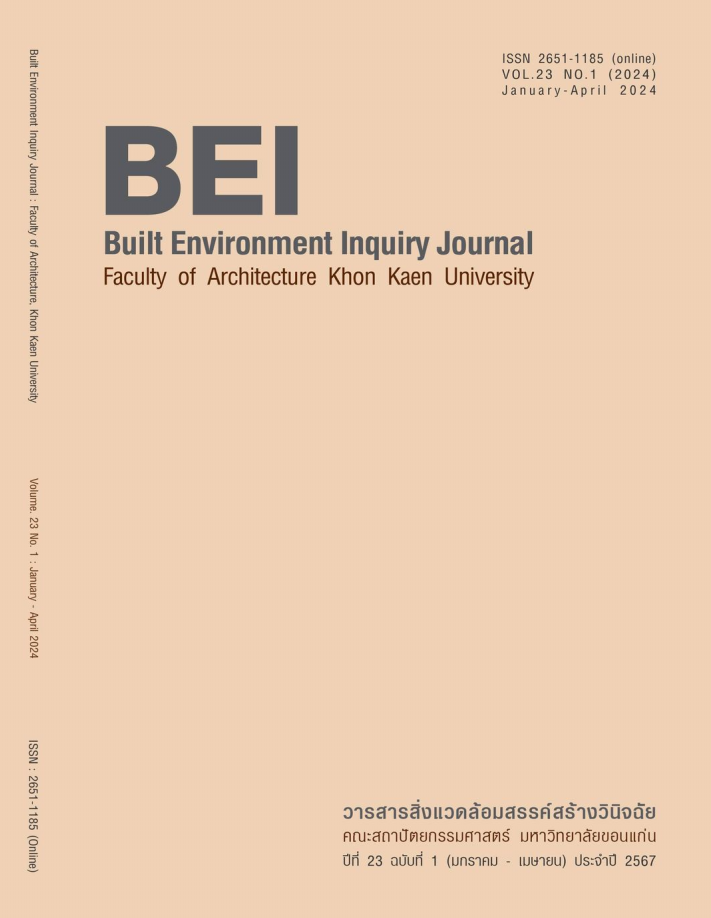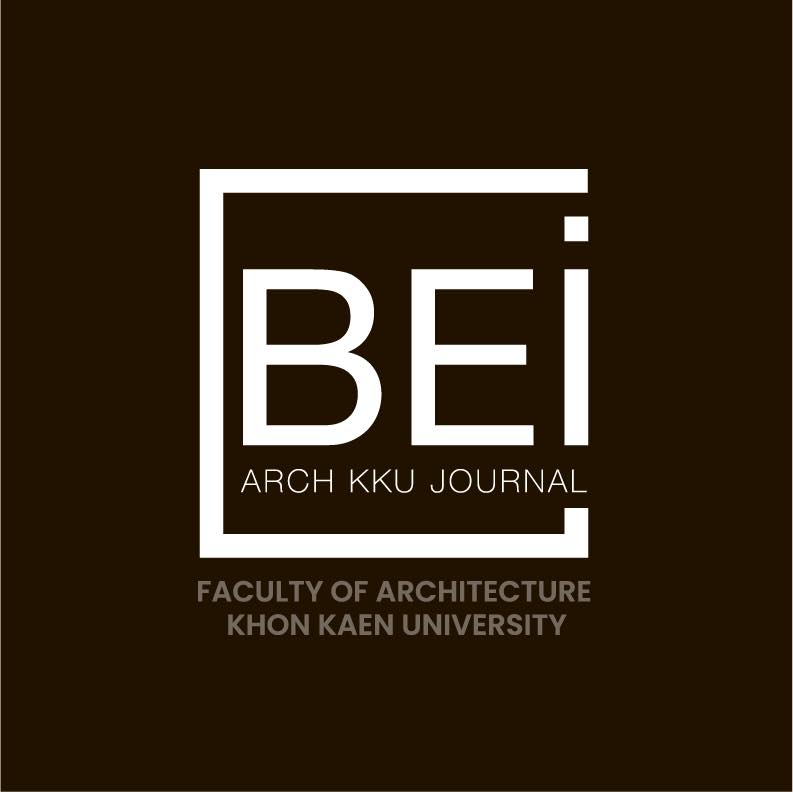Employees’ Response to Hybrid Work Environment
DOI:
https://doi.org/10.14456/bei.2024.8คำสำคัญ:
Physical Environment, Hybrid Working, Work Performance, Employees’ Feedback, Online Mediaบทคัดย่อ
ในขณะที่เรากำลังก้าวผ่านช่วงเวลาของสถานการณ์โรคระบาด การทำงานแบบไฮบริดได้รับความสนใจขึ้นอย่างมาก ในการเป็นแนวทางการทำงานภายหลังโควิด จากการทบทวนวรรณกรรมได้แสดงให้เห็นถึงผลกระทบด้านต่าง ๆ ของการทำงานแบบไฮบริดที่มีต่อพนักงานและงานที่ทำ การวิจัยนี้มีวัตถุประสงค์เพื่อประเมินความคิดเห็นของพนักงานต่อสภาพแวดล้อมการทำงานแบบไฮบริด และสำรวจความสัมพันธ์ระหว่างสภาพแวดล้อมกายภาพด้านต่าง ๆ และปัจจัยที่มีผลต่อความสำเร็จในการทำงาน การศึกษานี้ใช้กรณีศึกษาจากบริษัทผลิตข่าวออนไลน์ในประเทศไทย เพื่อสำรวจว่าหลักการต่าง ๆ ที่พบในการทบทวนวรรณกรรมได้มีการประยุกต์ใช้ในทางปฏิบัติอย่างไร วิธีการวิจัยประกอบด้วยการสัมภาษณ์ผู้จัดการทั่วไป และการแจกแบบสอบถามเพื่อประเมินความพึงพอใจของพนักงาน การสนับสนุนผลิตภาพในการทำงาน และการรับรู้ความสัมพันธ์ระหว่าง สภาพแวดล้อมกายภาพด้านต่าง ๆ และปัจจัยที่มีผลต่อความสำเร็จในการทำงาน การวิจัยนี้ใช้สถิติเชิงพรรณนาและการวิเคราะห์เนื้อหา ผลการศึกษาพบว่าแนวคิดสถานที่ทำงาน และการจัดวางสภาพแวดล้อมในการทำงาน ที่ได้รับผลกระทบจากบริบทขององค์กร (ได้แก่ ประเภทธุรกิจ โครงสร้างองค์กร และลักษณะของพนักงาน) ส่งผลต่อความพึงพอใจของพนักงานและการสนับสนุนผลิตภาพในการทำงาน นอกจากนี้ การสนับสนุนผลิตภาพในการทำงานของพนักงานและของทีมยังพบว่ามีส่วนช่วยสนับสนุนด้านความพึงพอใจของพนักงาน เงื่อนไขทางสภาพแวดล้อมกายภาพ และเทคโนโลยีสารสนเทศและการสื่อสารยังเชื่อมโยงกับปัจจัยต่าง ๆ ที่มีผลต่อความสำเร็จในการทำงาน การศึกษานี้ได้นำเสนอข้อค้นพบที่เชื่อมโยงความสัมพันธ์ระหว่างปัจจัยด้านสภาพแวดล้อมกายภาพและปัจจัยที่สนับสนุนความสำเร็จในการทำงานของพนักงาน
เอกสารอ้างอิง
Abrams, Z. (2019). The future of remote work. American Psychological Association. Retrieved
September 3, 2021, from http://apa.org/monitor/2019/10/cover-remote-work
Bangkok Post (2022). The best of both world. Retrieved October 6, 2021, from http://
bangkokpost.com/life/social-and-lifestyle/2229795/the-best-of-both-worlds
Beyer, J. E., & Marshall, J. (1981). The Interpersonal Dimension of Collegiality. Nursing Outlook,
, 29(11): 662-665
Budie, B., Appel-Meulenbroek, R., Kemperman, A., & Weijs-Perree, M. (2019). Employee
satisfaction with the physical work environment: the importance of a need based
approach. International Journal of Strategic Property Management, 23(1), pp. 36-49
Bureau of Labor Statistics (2020). Employed persons working at home, workplace, and time spent
working at each location. Retrieved October 15, 2021, from hppt://bls.gov/news.release/
atus.t06.htm
Fenker, M. (2008). Towards a theoretical framework for usability of buildings, in Alexander, K. (Ed.)
Usability of Workplaces: Phase 2, International Council for Research and Innovation in
Building and Construction, Rotterdam
Freihoefer, K., Guerin, D., Martin, C., Kim, H.Y., & Brigham, J.K. (2015). Occupants’ satisfaction with,
and physical readings of, thermal, acoustic, and lighting conditions of sustainable offie
workspaces. Indoor and Built Environment, 24(4), pp. 457-472
Gartner (2021). Gartner CFO Survey. Retrieved December 6, 2021, from https://www.gartner.com/
en/newsroom/press-releases/2020-04-03-gartner-cfo-surey-reveals-74-percent-oforganizations-to-shift-some-employees-to-remote-work-permanently2
Graham, G., & Greenhill, A. (2013). Exploring interaction: print and online news media synergies.
Internet Research, 23(1). pp. 89-108
Grewal, D., Janakiraman, R., Kalyanam, K., Kanan, P.K., Ratchford, B., Song, R., & Tolerico, S. (2010).
Strategic online and offlne retailing pricing: a review and research agenda. Journal of
Interactive Marketing, 24(2), pp. 138-54
Grubenmann, S., & Meckel, M. (2014). Metaphors of occupational identity: traces of a changeable
workplace in journalism. The 74th Annual Meeting of the Academy of Management,
Philadelphia, PA, USA. August 4 - 5, 2014
Halford, S. (2005). Hybrid workspace: re-spatialisations of work, organisation and management.
New Technology, Work and Employment, 20(1), pp. 19-33
Hillier, B., & Leaman, B. (1976). Architecture as a discipline. Journal of Architectural Research, 5(1),
pp. 28-32
Huang, E., Davison, K., Shreve, S., Davis, T., Bettendorf, E., & Nair, A. (2006). Bridging Newsrooms
and Classrooms: Preparing the Next Generation of Journalists for Converged Media.
Journalism & Communication Monographs, 8(3), pp. 221–262
Illegems, V., & Verbeke, A. (2004), Telework: What does it mean for management. Long Range
Planning, 37(4), pp. 319-334
Kamaruzzaman, S.N., Egbu, C.O., Zawawi, E.M.A., Karim, S.B.A., & Woon, C.J. (2015). Occupants’
satisfaction toward building environmental quality: structural equation modeling
approach. Environmental Monitoring and Assessment, 187(5), pp. 1-21
Kirk, J. & Belovics, R. (2006). Making e-working work. Journal of Employment Counseling, 43(1), pp.
-4606
Knight, P.J., & Westbrook, J.D. (1999). Comparing Employees in Traditional Job Structures vs
Telecommuting Jobs Using Herzberg’s Hygiene & Motivators. Engineering Management
Journal, 11, pp. 15-20
Kowalski, K.B., & Swanson, J.A. (2005). Critical success factors in developing teleworking programs.
Benchmarking: An International Journal, 12, pp. 236-249
Mangani, A., & Tarrini, E. (2017). Who survives a recession? Specialization against diversifiation in
the digital publishing industry. Online Information Review, 41(1), pp. 19-34
Matli, W. (2020). The changing work landscape as a result of the Covid-19 pandemic: insights from
remote workers life situations in South Africa. International Journal of Sociology and
Social Policy, 40(9/10), pp. 1237-1256
Microsoft (2021). The Work Trend Index: The next great disruption is hybrid work - are we ready?
Retrieved October 6 2021, from http://microsoft.com/en-us/worklab/work-trend-index/
hybrid-work
Mwiya, M., Phiri, J., & Lyoko, G. (2015). Public Crime Reporting and Monitoring System Model Using
GSM and GIS Technologies: A Case of Zambia Police Service. International Journal of
Computer Science and Mobile Computing, 4(11), pp. 207-226
Nilles, J. (1975). Telecommunications and organizational decentralization”, IEEE Transactions on
Communications, 23, (10), pp. 1142-1147
Shelly, G.B., Cashman, T.J., Waggoner, Gloria, A.W., & Waggoner, W.C. (1998). Discovering
Computers 98: A Link to the Future: World Wide Web Enhanced, Course Technology,
Massachusetts
Van der Voordt, D. J. M., & Van Wegen, H. B. R. (2005). Architecture in use: an introduction to the
programming, design and evaluation of buildings. UK: Architectural Press
Windlinger, L., Nenonen, S., & Airo, K. (2016). Specifiation and empirical exploration of a usability
concept in the workplace. Facilities, 34 (11/12), pp. 649-661
ดาวน์โหลด
เผยแพร่แล้ว
รูปแบบการอ้างอิง
ฉบับ
ประเภทบทความ
สัญญาอนุญาต
ลิขสิทธิ์ (c) 2024 สิ่งแวดล้อมสรรค์สร้างวินิจฉัย

อนุญาตภายใต้เงื่อนไข Creative Commons Attribution-NonCommercial-NoDerivatives 4.0 International License.
ทัศนะและข้อคิดเห็นของบทความที่ปรากฏในวารสารฉบับนี้เป็นของผู้เขียนแต่ละท่าน ไม่ถือว่าเป็นทัศนะและความรับผิดชอบของกองบรรณาธิการ




